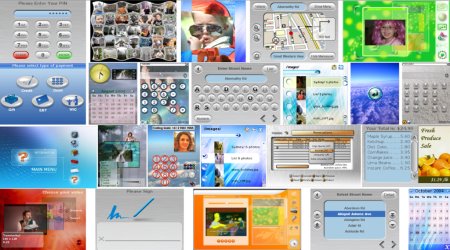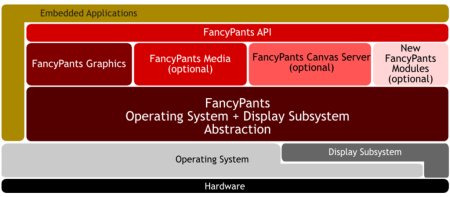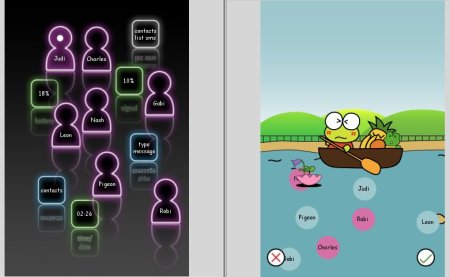GUI framework supports Android, adds Lua scripting
Dec 14, 2009 — by Eric Brown — from the LinuxDevices Archive — 22 viewsFluffy Spider Technologies (FST) announced a new version of its Linux-ready “FancyPants” lightweight embedded graphics framework for consumer electronics. FancyPants 3.0 adds Android support, 3D effects, virtualization and multi-processor support, and “Lua” scripting, and it decouples UI design from underlying code, enabling more third-party control over UI modifications, says FST.
Major new features in FancyPants 3.0 are said to include:
- Lua scripting and UI decoupling — Developers and integrators can create and customize user interfaces quickly with minimal coding investment, supporting decoupling of UI from application code, says FST (see farther below).
- Display and theme sharing — Version 3.0 enables applications running in virtual machines and on different CPUs in multi-core systems to output on a single physical display with a unified look-and-feel, even across different operating systems (OSes).
- Android support — Developers and OEMs can create highly differentiated devices and applications for Android while maintaining full interoperability with Android Market applications, says the company.
- New 2D and 3D graphics effects — Features include 2D kinetic scrolling, object animation, transforms, and dynamic alpha blending on all objects including video, plus many new 3D effects, such as folds, rotations, and cubes. Minimal acceleration technology (OpenGL/ES 1.0) is said to be required.

FancyPants 3.0 interface examples
(Click to enlarge)
"With Lua scripting, it's really easy to put together a UI with our API," said FST founder and CEO Robi Karp, in an interview with LinuxDevices. "We've gone a long way to make sure it's a simple, high-level API that can run across multiple operating systems, use virtualization, and integrate nicely with Android."

FancyPants 3.0 architecture
(Click to enlarge)
Karp emphasized that this decoupling goes far beyond what's typical, and is not limited to custom themes, icon sets, and color schemes. "This goes beyond programmable widgets," said Karp. "You can have an entire spreadsheet program, and change the UI dynamically on the fly, or have a widget dashboard app written with FancyPants that dynamically changes the layout based on the number of widgets."
FancyPants 3.0 lets application developers specify generic or abstract presentation of controls, widgets, and even content, says Karp. Because there is no predefined template layout requirement for any given screen with FancyPants 3.0, the same application can drive two entirely different looking interfaces (see images below).
"You can have completely different UIs with different presentable features for the same app, so developers can add their own data and branding, using different UIs for low-end and high-end variations on a device," said Karp. "It's particularly useful for developing a related family of products."

OEM-supplied SMS application (left), and third-party add-on UI for app (right)
(Click to enlarge)
For example, design components can integrate reactions to new device events and capabilities, such as shaking and orientation (accelerometer), location and movement (GPS), and definable data and network events, as provided by inputs such as calendars, stock quotes, sports scores, or wireless traffic, says FST.

OEM-supplied contacts application (right), and third-party add-on UI (left)
(Click to enlarge)
The decoupling technology and Android support are part of an effort to push FancyPants 3.0 into mobile phones and other mobile devices offered by various wireless carriers, which want to add their own branding.
It also serves the needs of independent Android app developers looking to stand out from the crowd. Currently, most Android developers use the graphics tools that ship with Android, but with the proliferation of similar apps, they are more likely to look for new tools in order to differentiate, says Karp. That provides an opportunity for FancyPants, which offers extensive libraries of special effects and other advanced features, he added.
FancyPants 3.0's new virtualization support also fits in nicely with what Karp sees as a continuing move toward use of microkernel virtualization on multi-core processors. "One of the Holy Grails of mobile phone operators is to keep their core operating system secure and still enable third party applications to be securely and safely deployed," said Karp. "With FancyPants, if you have two CPUs virtualized, the UI can be easily modified while the core app can be cordoned off."
Fluffy background
Sydney, Australia based FST last revised its mature FancyPants GUI design framework to a version 2.0 in May 2008, adding object-oriented scripting, custom video thumbs, and the ability to run multiple embedded applications simultaneously on the same screen. The software supports ARM, X86, PowerPC, and MIPS32 platforms, and includes a software development kit (SDK) and optimized, small footprint runtime libraries that support Linux, Symbian/UIQ, Windows, and L4 OSes.
The primary focus, however, is with Linux, running on devices including "anything with a screen," according to Karp, including home media centers, portable media players, and mobile phones. Founded in 1995, FST boasts customers including Toshiba, VeriFone, SpeakerCraft, Ericsson, HP, Vodafone, and GEC.
Availability
FancyPants 3.0 will be available tomorrow at an undisclosed price. More information may be found here.
This article was originally published on LinuxDevices.com and has been donated to the open source community by QuinStreet Inc. Please visit LinuxToday.com for up-to-date news and articles about Linux and open source.